Ellen and Jim Have a Blog, Too
We are two part-time academics. Ellen teaches in the English department and Jim in the IT program at George Mason University.


The Pallisers 2:3: Burgo & the female beggar · 8 September 07
Dear Marianne,
I’m writing a separate letter on a scene at the end of Chapter 29 (“Burgo Fitzgerald) in Trollope’s Can You Forgive Her? and its transformation in the 1974 BBC Pallisers 2:3: it’s touching in the book, and brilliant in the film.
We see Burgo (Barry Justice) walking late at night in the streets; we hear his shoes as they hit the pavements and in the distance the sound of a train setting off. He is dressed super-elegantly; he comes up to a hotel and we hear horses’ hooves setting off.
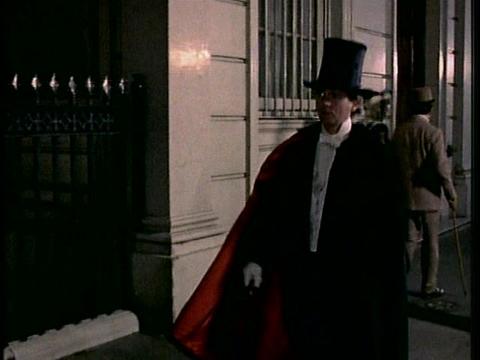
A girl of the streets (Stacey Tendeter), probably a prostitute and alcoholic comes up to him.
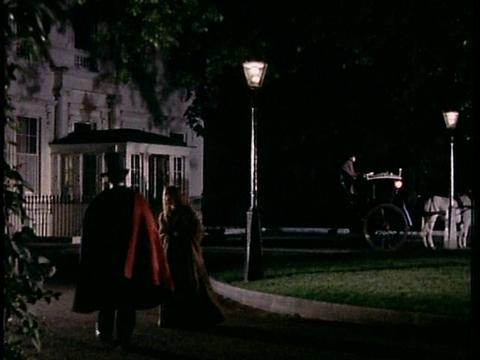
Girl: Please, sir. (Medium shot)
(Burgo seems to move on, attempt to shake her off so she stands in front of him and cluthes him by the shoulders to get his attention.)
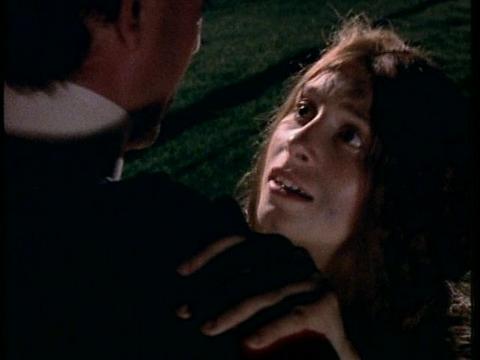
Girl: Please, sir (her hands moving quirkily, desperately clutching him), spare a penny for a glass of gin. Feel me hands, sir, how cold it is.
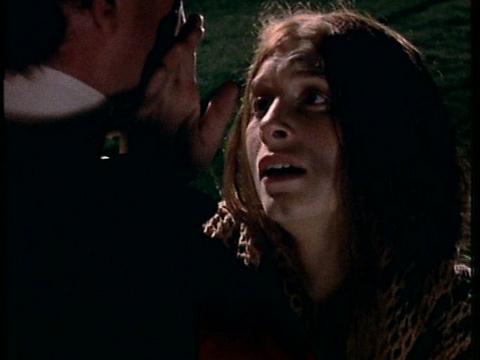
(The camera moves to his startled face as he sees a mirror image of himself writ large in her.)
Burgo: Yes, you’re cold enough, all right. (His hands have white gloves on them.)
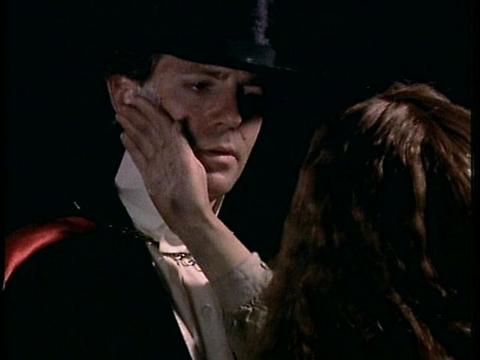
Girl: God! If you knew what it was to be so cold! I’ve nothing in the world. Not a penny. Not even a hole to lie in.
Burgo: We’re the same then: for I too have nothing. You cannot be poorer than than I am. (He sees her as a mirror image of himself.)
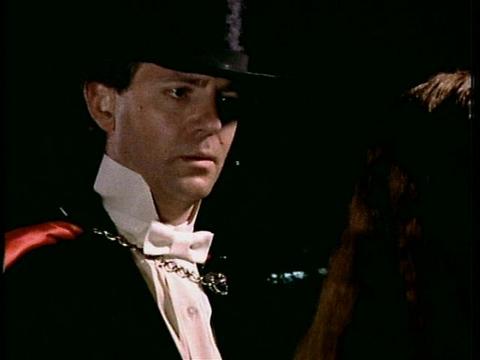
Girl: You poor? (She backs away and looks at him; we see in her eyes she finds him beautiful.) Oh! Gracious. How beautiful you are. Such as you are never poor.
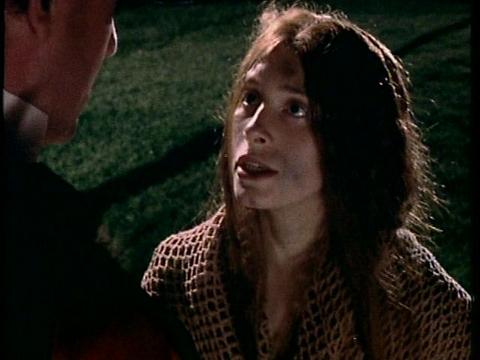
Burgo: I’m a deal poorer, my girl. You have nothing. I have £30,000 worse than nothing. (His face as intensely strained as his voice.)
(The girl, puzzled, looks at him.)
Burgo: Well, let’s see, well, if I travel third class to Monkshade … (He holds a coin in front of her.)
Girl: What’s that, sir?
Burgo: (Smiling.) Nothing to you. Will that get you a bed and a meal?
Girl: (Nods.) Oh, and breakfast too.
Burgo: Well, you take it.
(Girl goes for it with a smile, but he holds fast for a moment.)
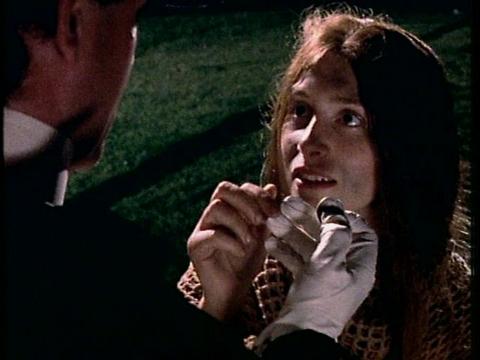
Burgo: But promise me one thing first. Don’t spend it on gin. (Intense expression on his face reveals his identification with her as someone who needs to drink heavily, and his desire to see her refrain so as to spend the money on food, shelter, and warmth.)
Girl: I promise.
Burgo: Here you are then.
(She grabs his hand & hugs it tight to her face.)
Girl: Oh! Ah! I wish that I might see you again. Because you’re so good and beautiful. (Camera’s light shines full on her face.)
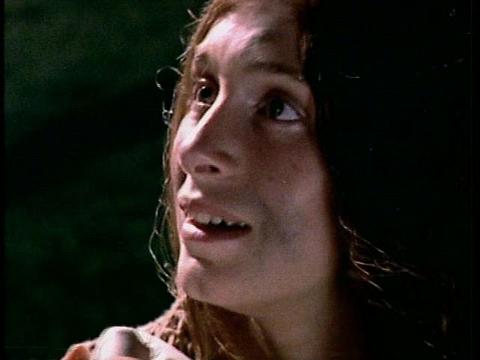
(He smiles at her, grimacing, moves away, turns and takes off his hat and bows, and then walks on.)
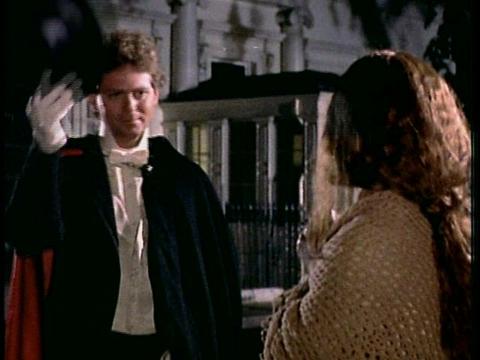
The next frame is of Lady Glencora Palliser (Susan Hampshire) reading aloud Tennyson’s poetry to Alice Vavasour (Caroline Mortimer): childlike in her gestures, and self-evidently knowing almost nothing of money or how to support herself, the juxtaposition reveals this is what Lady Glencora is in danger of. All her money does her no good since she has no control over it.
The scene’s literal source is Trollope’s book, only there is a great difference. Some of the words are literally the same, but Trollope’s character is not desperate, nor does he identify; he is under no strain. He takes the girl to a public-house and buys her food and drink, is relaxed enough to notice she is too embarrassed to eat in front of him so turns his back to her while she eats. We are told he does not try to go to bed with her nor act roughly and arrogantly, and insteads extracts a promise she will use the money he now gives her for a bed and breakfast. He feels for her and pities her, and our narrator tells us has gives her the coin “to comfort” her because she has “spoken to him in the streets.” The overall structure of Trollope’s book invites us to see a parallel between the girl and Lady Glencora, but it’s not done viscerally directly.
The real source of the scene’s power and characters’ inner lives is in Simon Raven whose memories of his own drinking, encounters in the streets with those he saw also as outcasts. For Raven the girl is the real thing without disguises. His outcast state (gay, blackmailed) and remembered desperation is poured into the different parallel his Burgo recognizes.
I’ve identified my problem in writing about film adaptations of novels. First about the Palliser films. Can I write about the 1974 Pallisers in its own right and against let’s say Simon Raven’s other work (novels and film adaptations, memoirs and essays), then in terms of its genre, and only finally in terms of Trollope’s Palliser novels? I want to analyze these films in terms of themselves.
Then the Austen movies. Can I write about the 1972 Emma in its own right and against let’s say Denis Constanduros’s Acacia Avenue and his Sense and Sensibility (the script for the 1981 S&S is by Constanduros) as a type of adaptation? then see the film as a product of a genre (costume drama, comic familial melodrama), the first in a 40 year development,;and only after all this, how it relates to Austen’s Emma, the other 3 Emma films available, and then and what it, together with the other film adaptations of Austen, reveal about Austen.
In all the above stills more is communicated or makes the meaning as much as the words. The actors count so much; one cannot overemphasize the importance of their ability, looks, the sounds of their voices.
Do I have to write about the 1973 film Emma in terms of the other film adaptations of Austen’s novel, Emma and Emma itself? To do so is simply to repeat what others have said. Perhaps I could produce a more perceptive analysis, but I’ve learnt most readers don’t care about this. I would be doing to their eyes just what others do. Ho hum.
So while I know I do these projects to keep myself cheerful and occupied, and doing what I respect and fulfills me, I don’t want to go on to a book (hard work) unless I’m doing something genuinely constructive and true and which somehow genuinely contributes to the discussion fundamentally. I want really to understand the material in the stills of the pathetic Burgo (Barry Justice) seen from the back by then calmed female beggar (Stacey Tendeter):
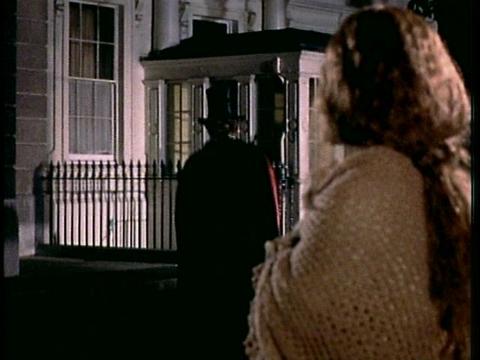
Elinor
--
Posted by: Ellen
* * *
Comment
- From Nick:
“There is a vast critical apparatus of movie criticism, lots of academic courses, movies are written about seriously in the papers etc. etc. – certainly in the UK and I am sure this must be true in the US as well?
What is not taken seriously, in the UK at any rate, is TV. I am sure, as you say, the Davies book is an exception. So it would seem to me there is plenty of space for your project in terms of the TV adaptations, and plenty of seriousness in terms of the movies (if that makes any sort of sense).
I have cut and pasted an article from The Times Books section about an adaptation of Susan Minot's Evening (I don’t know the writer or book – the film sounds good) which I read yesterday and thought of you – I think there are some interesting points about the nature of adaptation and the new work which emerges. It is the whole question of adaptation and how it is affected by the cultural, technical etc. contexts in which it is carried out which would interest me most Ellen – but then I am rather odd!
It begins:
‘From The Times
September 8, 2007
IF SUSAN MINOT COULD PASS on one piece of advice to any writer whose book is snapped up by Hollywood it would be short and sweet. “I would tell them ‘let it go’,” she says. “Just stand back and enjoy the ride.” It is easier said than done. And there were times when she had to remind herself of her own counsel as her novel Evening undertook a tortuous nine-year journey to the big screen including, finally, handing over her own version of the screenplay to another author, Michael Cunningham, to rewrite.
“It was like watching a parade,” she says of Evening’s transformation into cinema, with a cast including Vanessa Redgrave, Meryl Streep, Claire Danes and Glenn Close. ‘I’m the only one that wrote the book. I did one version and Michael did his.
If pressed, I think I’m going to say I like mine better but, you know, Michael’s was his. He brought a lot of people to the project and he managed to make the story more accessible’” ...
Cunningham was well aware of the danger of treading on a fellow writer's toes. His own novel The Hours was adapted by David Hare in 2002 and went on to win a Golden Globe for Best Picture and a Best Actress Oscar for Nicole Kidman.
"I loved Susan's book and I respect her enormously as a writer and the first thing I did was call and say 'I don't know what they'll be, but I know I'm going to have to make real changes in the story'," he recalls.
"I assured her that I wanted to be absolutely true to the heart and soul of the book but that I would be pushing for significant changes. I said to her: 'If that's a problem for you tell me now and I won't do it.' My first loyalty is always to the novelist.
"To her huge credit, Susan said: 'Of course you'll change it, that's why they called you. That's what I want to see happen.' What works in a novel is not what works in a movie, and off we went ... "
E.M.
— Elinor Sep 9, 10:59am # - I note the contradiction in logic: you cannot have the same heart and soul of a book if you make central and important changes, quite apart from the difference in media (movies as opposed to books) which makes transformation changes.
— Elinor Sep 9, 11:04am # - Dear Ellen, I very much enjoyed this blog, with all the beautiful stills and the transcript of the dialogue.
For me, this was one of the scenes which made the strongest impression in both the novel and the TV series – I hadn’t previously quite realised the differences between them which you draw out so clearly.
In the screen version, the fact of Burgo himself being in such desperate straits when he helps the girl reminds me of a moment which made an impression on me as a child, in ‘A Little Princess’ by Frances Hodgson Burnett. Here, Sara, the ‘princess’ fallen on hard times, is given six bread rolls by a kindly baker, and gives five of them to a starving street child, Becky – even though she is almost starving herself.
Of course, there are differences between the two situations – Burgo might be £30,000 in the red but he isn’t physically hungry and cold – but I think in both cases there’s a feeling of the once rich and privileged person who has lost their wealth, and is standing on the brink of destitution, still wanting to cling on to the feeling of being able to reach out and help others who are even worse off. I suppose it is also their own suffering giving them a feeling for the pain of others.
Jumping back to Trollope, I’ve been trying to think if there are many other moments in his novels where a character is brought face to face with poverty as starkly as Burgo is here. All I can come up with is the horrific scene of the mother with the dead child in ‘Castle Richmond’, where it is too late to reach out and help. Probably there are other incidents which I’ve forgotten, though.
I do think the meeting with the girl makes Burgo far more sympathetic and suggests he could have been something more than the wastrel he becomes.
Speaking for myself as a reader, I think it would be very interesting to see the Austen adaptations not only compared to the books, but put in context of the times they were made in and the other films surrounding them in the marketplace, as well as within their genres. As coincidence would have it, I’ve just watched a BBC2 documentary about British films of the 1940s and 50s which (briefly) considered two literary adaptations, ‘The Innocents’ (a version of James’ ‘The Turn of the Screw’) and ‘The Rocking Horse Winner’, based on a story by DH Lawrence, alongside other psychological horror films of the period, rather than referring back to the books they came from.
— Judy Sep 11, 5:05pm # - A few days ago you were thinking about Grace Paley’s poetry. Here is the URL for an article on that, with some additional examples.
http://www.forward.com/articles/11492/
— bob Sep 11, 8:23pm # - You put your comment in the wrong spot, Bob :). Actually I can’t say that Paley means that much to me; it was a passing reaction to threads on two lists, some poems put on the lists, and memory of liking the stories and the presence in them.
For all I know were I to read the stories now I might not think so well of them. At the time, it was hard to get access to new authors who could speak home to me. The public media is so controlled (meaning TV and what I came across in school or published books). I have a strong tendency not to prefer American literature that much but to turn to European (English, French, Italian) and hyphenated English types (Anglo-Indiana and Anglo-Irish and so on).
This project of movies could not have been possible without the new releases of DVDs and new software which enables me to watch them very slowly.
E.M.
— Elinor Sep 12, 4:23pm # - Dear Judy,
Thank you for your careful thoughts and perceptive memories. I like another sequence very much close to this one of Burgo and the female beggar. It is of Lady Glencora going out into the Priory ruins late at night. It’s very gothic in the film, and now I know the place is brought back at the end of the series so that Lady Glen as Duchess goes there nightly and talks with Plantagenet (now Duke); a walk precipates a serious illness, and at the last episode in the same place Mrs Finn (Madame Max that was) insistently tries to persuade the Duke to allow his son and daughter to marry freely as Lady Glen wanted that so, and only that way will they know real happiness.
I have been thwarted by another bad DVD. My second DVD (Volume 2, parts 3 and 4) is now broken. My vlc media player won’t read it. I tried to do what I’ve been doing with videos and discover I can’t take down what’s being said because when I hit pause I don’t come back to the point I was at. I also can’t get good snapshots. So I have this time rebought the DVD and will wait for it to come; I can’t keep doing this and it may be I’m doing something with these DVDs they are not meant for. Jim has encouraged me to spend the money this time (and perhaps further times) because he thinks the project very worth while. But if this does keep happening I may have to switch back to covering all the Trollope movies and not doing this single vast cycle in depth—which was my idea and what I thought someone might value enough to want a book about from me who would have nothing else to offer.
There does seem to be such interest in film adaptation suddenly, no? Surely we’re not making it up because we are interested (?—I’m grinning a bit).
I think I shall have to give up my idea of trying to contextualize the film adaptations with other film adaptations by the same author. I don’t know enough about the screenplay writers’ other work, and the comparisons become too general and abstract. I can use some of this author-rooted stuff, but my structure for my book cannot be this.
Yes the best thing is to try to show the development of film adaptations out of one another era through era—but also in terms of type. Davies’ 2007 NA reverts back to the faithful ones of the 1970s, 80s, and clearly 90s (he wrote some of them), while the 2007 Persuasion and Mansfield Park are more like the recent analogous and critical adaptations (say Rozema’s and the Meridian Emma).
It’s very good for me to have someone whose judgement I respect to dialogue with or I go off on tangents.
Today I’ve been watching the 1981 Sense and Sensibility and admit I like parts of it very much. Irene Richards and one of the sequences of scenes moved me to tears at one point. It’s an interesting failure, and the idea I have would indeed allow me to see the later S&S in terms of this and for my own interest compare the free S&S (the Bollywood one).
I’ve not forgot the suggestion on WWTTA to see the film adaptation of one of Lehmann’s books, but I haven’t had time. I think I too love to return to these visions of the past.
Ellen
— Elinor Sep 12, 4:33pm # - Judy remarked:
“Jumping back to The Pallisers and Burgo, I like your drawing out of the similarity between Glencora’s wandering in the ruins, and making herself ill, and Burgo wandering in the streets – both of them cut off and alone.
I’ve been wondering about why it is that these scenes of beautiful and gifted people self-destructing can be so compelling – and haven’t really come up with any answers. In the last few days I’ve watched a movie from the 1980s, ‘Bright Lights, Big City’ (another literary adaptation, though I’ve never read the novel, by Jay McInnerny, and don’t know anything much about it) where Michael J Fox was playing a drug-addicted writer “working his way to the bottom.” It was partly that he was disillusioned with 1980s pursuit of wealth, but more that he couldn’t cope. He again seemed to be someone with so many possibilities but throwing them all away.
Sydney Carton in A Tale of Two Cities is another example. Both of these characters love women who reject them, as with Glencora and Burgo – but I don’t get the sense that the authors or directors are blaming the men’s plight on the women turning them away (or not entirely), as all of them were already in the destructive spiral before being rejected.
I’m not sure if there are so many women characters who fall apart in this kind of way, or if it is more a storyline that recurs with men. I suppose historically it has more often been men who turn to drinking and gambling as their means of embracing ruin.
Judy”
— Elinor Sep 16, 10:17am # - A brief (inadequate) reply:
An interesting thought We also like stories in literature of beautiful and gifted people self-destructing. This is a typical theme for BookerPrize books. Perhaps it’s consoling and strengthening (why this latter is hard to explain) to see this put before us as we can recognize aspects of ourselves and the depiction flatters as well as explains in a finally compassionate way.
E.M.
— Elinor Sep 16, 10:18am #
commenting closed for this article
